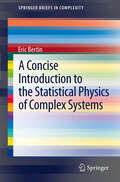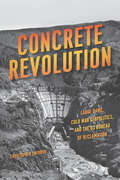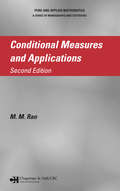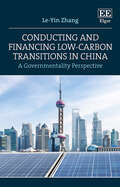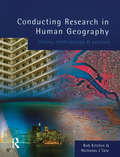- Table View
- List View
Concise Introduction to Sustainable Consumption (Elgar Concise Introductions)
by John ThøgersenOur Elgar Concise Introductions are inspiring and considered introductions to the key principles in business, expertly written by some of the world’s leading scholars. The aims of the series are two-fold: to pinpoint essential principles of business and management, and to offer insights that stimulate critical thinking.Examining the psychological and social drivers of unsustainable and sustainable consumption, this Concise Introduction provides an insightful overview of the causes of unsustainable consumer behaviour and the instruments and interventions needed to create a sustainable consumption pattern. Key Features:Outlines how policy interventions can contribute to a transformation in the consumption patternBased on a comprehensive model of the causes and consequences of (un)sustainable consumer choicesProvides a precise account of how the structure and distribution of consumption are responsible for environmental problemsMaps the roots of unsustainable consumption in human nature as well as in economic, institutional, social, and structural contextsHighlighting a variety of ways to promote sustainable consumption, from sustainability labelling to carbon taxes and infrastructure investments, this Concise Introduction will be essential reading for students and researchers in behavioural sciences, business and management, economic psychology, environmental sociology, and sustainable development.
A Concise Introduction to the Statistical Physics of Complex Systems (SpringerBriefs in Complexity)
by Eric BertinThis concise primer (based on lectures given at summer schools on complex systems and on a masters degree course in complex systems modeling) will provide graduate students and newcomers to the field with the basic knowledge of the concepts and methods of statistical physics and its potential for application to interdisciplinary topics. Indeed, in recent years, statistical physics has begun to attract the interest of a broad community of researchers in the field of complex system sciences, ranging from biology to the social sciences, economics and computer science. More generally, a growing number of graduate students and researchers feel the need to learn some basic concepts and questions originating in other disciplines without necessarily having to master all of the corresponding technicalities and jargon. Generally speaking, the goals of statistical physics may be summarized as follows: on the one hand to study systems composed of a large number of interacting ‘entities’, and on the other to predict the macroscopic (or collective) behavior of the system considered from the microscopic laws ruling the dynamics of the individual ‘entities’. These two goals are, to some extent, also shared by what is nowadays called ‘complex systems science’ and for these reasons, systems studied in the framework of statistical physics may be considered as among the simplest examples of complex systems—allowing in addition a rather well developed mathematical treatment.
A Concise Introduction to Thermodynamics for Physicists
by Patricia FaiscaThis introductory textbook provides a synthetic overview of the laws and formal aspects of thermodynamics and was designed for undergraduate students in physics, and in the physical sciences. Language and notation have been kept as simple as possible throughout the text. While this is a self-contained text on thermodynamics (i.e. focused on macroscopic physics), emphasis is placed on the microscopic underlying model to facilitate the understanding of key concepts such as entropy, and motivate a future course on statistical physics. This book will equip the reader with an understanding of the scope of this discipline and of its applications to a variety of physical systems Throughout the text readers are continuously challenged with conceptual questions that prompt reflection and facilitate the understanding of subtle issues. Each chapter ends by presenting worked problems to support and motivate self-study, in addition to a series of proposed exercises whose solutions are available as supplementary material. Features Pedagogically designed, including illustrations, keyword definitions, highlights, summaries of key ideas and concepts, and boxes with additional topics that complement the materials presented in the main text. Presents active reading strategies, such as conceptual problems, discussion questions, worked examples with comments, end of chapter problems, and further reading to stimulate engagement with the text. Guides the reader with ease through a difficult subject by providing extra help whenever needed to overcome the more demanding technical and conceptual aspects. Solutions Manual available upon qualifying course adoption.
A Concise Introduction to Thermodynamics for Physicists
by Patricia FaiscaThis introductory textbook provides a synthetic overview of the laws and formal aspects of thermodynamics and was designed for undergraduate students in physics, and in the physical sciences. Language and notation have been kept as simple as possible throughout the text. While this is a self-contained text on thermodynamics (i.e. focused on macroscopic physics), emphasis is placed on the microscopic underlying model to facilitate the understanding of key concepts such as entropy, and motivate a future course on statistical physics. This book will equip the reader with an understanding of the scope of this discipline and of its applications to a variety of physical systems Throughout the text readers are continuously challenged with conceptual questions that prompt reflection and facilitate the understanding of subtle issues. Each chapter ends by presenting worked problems to support and motivate self-study, in addition to a series of proposed exercises whose solutions are available as supplementary material. Features Pedagogically designed, including illustrations, keyword definitions, highlights, summaries of key ideas and concepts, and boxes with additional topics that complement the materials presented in the main text. Presents active reading strategies, such as conceptual problems, discussion questions, worked examples with comments, end of chapter problems, and further reading to stimulate engagement with the text. Guides the reader with ease through a difficult subject by providing extra help whenever needed to overcome the more demanding technical and conceptual aspects. Solutions Manual available upon qualifying course adoption.
Concrete Buildings in Seismic Regions, Second Edition
by George G. Penelis Gregory G. PenelisReinforced concrete (R/C) is one of the main building materials used worldwide, and an understanding of its structural performance under gravity and seismic loads, albeit complex, is crucial for the design of cost effective and safe buildings.Concrete Buildings in Seismic Regions comprehensively covers of all the analysis and design issues related
Concrete Buildings in Seismic Regions, Second Edition
by George G. Penelis Gregory G. PenelisReinforced concrete (R/C) is one of the main building materials used worldwide, and an understanding of its structural performance under gravity and seismic loads, albeit complex, is crucial for the design of cost effective and safe buildings.Concrete Buildings in Seismic Regions comprehensively covers of all the analysis and design issues related
Concrete Petrography: A Handbook of Investigative Techniques, Second Edition
by ALAN B. POOLE; IAN SIMSThis classic reference has established the value of petrography as a powerful method for the investigation of concrete as a material. It provides an authoritative and well-illustrated review of concrete composition and textures, including the causes of defects, deterioration, and failure that can be identified using a petrological microscope. This new edition is entirely revised and updated and also greatly extended to take account of new scientific developments and significant improvements in instrumentation and to reflect current laboratory working practices, as well as to reflect new understanding of the performance of concrete and related materials. Now in full color throughout, Concrete Petrography, Second Edition provides case study examples, with appropriate explanatory discussions and practical advice on selecting, handling and preparing specimens. It assists and guides the engineer, the trainee and the experienced petrographer in understanding the scientific evidence that is basic to petrographic analysis and so will lead to more accurate and timely diagnosis and treatment of problems in structural concrete. This book includes: Contributions in specialist areas by internationally recognized experts Explanation of computer techniques as an aid to petrography Full coverage of inspection, sampling, and specimen preparation New sections covering recent technological development of equipment Guidance on observation of cement and concrete mineralogy and microfabrics Discussion and illustrative examples of deterioration and failure mechanisms New work and guidance on the determination of water/cement ratio New color illustrations and micrographs throughout Thorough updating of standards, other authoritative publications, and references A fully revised, extended, and updated glossary of optical and other properties
Concrete Petrography: A Handbook of Investigative Techniques, Second Edition
by Alan B. Poole Ian SimsThis classic reference has established the value of petrography as a powerful method for the investigation of concrete as a material. It provides an authoritative and well-illustrated review of concrete composition and textures, including the causes of defects, deterioration, and failure that can be identified using a petrological microscope. This new edition is entirely revised and updated and also greatly extended to take account of new scientific developments and significant improvements in instrumentation and to reflect current laboratory working practices, as well as to reflect new understanding of the performance of concrete and related materials. Now in full color throughout, Concrete Petrography, Second Edition provides case study examples, with appropriate explanatory discussions and practical advice on selecting, handling and preparing specimens. It assists and guides the engineer, the trainee and the experienced petrographer in understanding the scientific evidence that is basic to petrographic analysis and so will lead to more accurate and timely diagnosis and treatment of problems in structural concrete. This book includes: Contributions in specialist areas by internationally recognized experts Explanation of computer techniques as an aid to petrography Full coverage of inspection, sampling, and specimen preparation New sections covering recent technological development of equipment Guidance on observation of cement and concrete mineralogy and microfabrics Discussion and illustrative examples of deterioration and failure mechanisms New work and guidance on the determination of water/cement ratio New color illustrations and micrographs throughout Thorough updating of standards, other authoritative publications, and references A fully revised, extended, and updated glossary of optical and other properties
Concrete Revolution: Large Dams, Cold War Geopolitics, and the US Bureau of Reclamation
by Christopher SneddonWater may seem innocuous, but as a universal necessity, it inevitably intersects with politics when it comes to acquisition, control, and associated technologies. While we know a great deal about the socioecological costs and benefits of modern dams, we know far less about their political origins and ramifications. In Concrete Revolution, Christopher Sneddon offers a corrective: a compelling historical account of the US Bureau of Reclamation’s contributions to dam technology, Cold War politics, and the social and environmental adversity perpetuated by the US government in its pursuit of economic growth and geopolitical power. Founded in 1902, the Bureau became enmeshed in the US State Department’s push for geopolitical power following World War II, a response to the Soviet Union’s increasing global sway. By offering technical and water resource management advice to the world’s underdeveloped regions, the Bureau found that it could not only provide them with economic assistance and the United States with investment opportunities, but also forge alliances and shore up a country’s global standing in the face of burgeoning communist influence. Drawing on a number of international case studies—from the Bureau’s early forays into overseas development and the launch of its Foreign Activities Office in 1950 to the Blue Nile investigation in Ethiopia—Concrete Revolution offers insights into this historic damming boom, with vital implications for the present. If, Sneddon argues, we can understand dams as both technical and political objects rather than instruments of impartial science, we can better participate in current debates about large dams and river basin planning.
Concrete Revolution: Large Dams, Cold War Geopolitics, and the US Bureau of Reclamation
by Christopher SneddonWater may seem innocuous, but as a universal necessity, it inevitably intersects with politics when it comes to acquisition, control, and associated technologies. While we know a great deal about the socioecological costs and benefits of modern dams, we know far less about their political origins and ramifications. In Concrete Revolution, Christopher Sneddon offers a corrective: a compelling historical account of the US Bureau of Reclamation’s contributions to dam technology, Cold War politics, and the social and environmental adversity perpetuated by the US government in its pursuit of economic growth and geopolitical power. Founded in 1902, the Bureau became enmeshed in the US State Department’s push for geopolitical power following World War II, a response to the Soviet Union’s increasing global sway. By offering technical and water resource management advice to the world’s underdeveloped regions, the Bureau found that it could not only provide them with economic assistance and the United States with investment opportunities, but also forge alliances and shore up a country’s global standing in the face of burgeoning communist influence. Drawing on a number of international case studies—from the Bureau’s early forays into overseas development and the launch of its Foreign Activities Office in 1950 to the Blue Nile investigation in Ethiopia—Concrete Revolution offers insights into this historic damming boom, with vital implications for the present. If, Sneddon argues, we can understand dams as both technical and political objects rather than instruments of impartial science, we can better participate in current debates about large dams and river basin planning.
Concrete Revolution: Large Dams, Cold War Geopolitics, and the US Bureau of Reclamation
by Christopher SneddonWater may seem innocuous, but as a universal necessity, it inevitably intersects with politics when it comes to acquisition, control, and associated technologies. While we know a great deal about the socioecological costs and benefits of modern dams, we know far less about their political origins and ramifications. In Concrete Revolution, Christopher Sneddon offers a corrective: a compelling historical account of the US Bureau of Reclamation’s contributions to dam technology, Cold War politics, and the social and environmental adversity perpetuated by the US government in its pursuit of economic growth and geopolitical power. Founded in 1902, the Bureau became enmeshed in the US State Department’s push for geopolitical power following World War II, a response to the Soviet Union’s increasing global sway. By offering technical and water resource management advice to the world’s underdeveloped regions, the Bureau found that it could not only provide them with economic assistance and the United States with investment opportunities, but also forge alliances and shore up a country’s global standing in the face of burgeoning communist influence. Drawing on a number of international case studies—from the Bureau’s early forays into overseas development and the launch of its Foreign Activities Office in 1950 to the Blue Nile investigation in Ethiopia—Concrete Revolution offers insights into this historic damming boom, with vital implications for the present. If, Sneddon argues, we can understand dams as both technical and political objects rather than instruments of impartial science, we can better participate in current debates about large dams and river basin planning.
Concrete Revolution: Large Dams, Cold War Geopolitics, and the US Bureau of Reclamation
by Christopher SneddonWater may seem innocuous, but as a universal necessity, it inevitably intersects with politics when it comes to acquisition, control, and associated technologies. While we know a great deal about the socioecological costs and benefits of modern dams, we know far less about their political origins and ramifications. In Concrete Revolution, Christopher Sneddon offers a corrective: a compelling historical account of the US Bureau of Reclamation’s contributions to dam technology, Cold War politics, and the social and environmental adversity perpetuated by the US government in its pursuit of economic growth and geopolitical power. Founded in 1902, the Bureau became enmeshed in the US State Department’s push for geopolitical power following World War II, a response to the Soviet Union’s increasing global sway. By offering technical and water resource management advice to the world’s underdeveloped regions, the Bureau found that it could not only provide them with economic assistance and the United States with investment opportunities, but also forge alliances and shore up a country’s global standing in the face of burgeoning communist influence. Drawing on a number of international case studies—from the Bureau’s early forays into overseas development and the launch of its Foreign Activities Office in 1950 to the Blue Nile investigation in Ethiopia—Concrete Revolution offers insights into this historic damming boom, with vital implications for the present. If, Sneddon argues, we can understand dams as both technical and political objects rather than instruments of impartial science, we can better participate in current debates about large dams and river basin planning.
Concrete Structures: Design and Residual Capacity Assessment
by Enrique Hernández-Montes Luisa María Gil-MartínBased primarily on Eurocode 2, this book offers a comprehensive exploration of theory alongside a substantial collection of solved examples. Intended for students and professionals specializing in structural engineering, the content delves into the fundamental aspects of designing and evaluating concrete structures. Discover a unique focus on both theoretical and practical aspects, empowering engineers to unearth solutions that minimize steel usage. Step into the realm of asymmetric and environmentally appealing alternatives, redefining the way we approach modern engineering challenges.
Concrete Structures: Design and Residual Capacity Assessment
by Enrique Hernández-Montes Luisa María Gil-MartínBased primarily on Eurocode 2, this book offers a comprehensive exploration of theory alongside a substantial collection of solved examples. Intended for students and professionals specializing in structural engineering, the content delves into the fundamental aspects of designing and evaluating concrete structures. Discover a unique focus on both theoretical and practical aspects, empowering engineers to unearth solutions that minimize steel usage. Step into the realm of asymmetric and environmentally appealing alternatives, redefining the way we approach modern engineering challenges.
Condensed Matter Applications of AdS/CFT: Focusing on Strange Metals (Springer Theses)
by Andrea AmorettiThe book deals with applications of the AdS/CFT correspondence to strongly coupled condensed matter systems. In particular, it concerns with the study of thermo-electric transport properties of holographic models exhibiting momentum dissipation and their possible applications to the transport properties of strange metals. The present volume constitutes one of the few examples in the literature in which the topic is carefully reviewed both from the experimental and theoretical point of view, including not only holographic results but also standard condensed matter achievements developed in the past decades. This work might be extremely useful both for scientific and pedagogical purposes.
Condensed Matter in a Nutshell (PDF)
by Gerald D. MahanCondensed Matter in a Nutshell is the most concise, accessible, and self-contained introduction to this exciting and cutting-edge area of modern physics. This premier textbook covers all the standard topics, including crystal structures, energy bands, phonons, optical properties, ferroelectricity, superconductivity, and magnetism. It includes in-depth discussions of transport theory, nanoscience, and semiconductors, and also features the latest experimental advances in this fast-developing field, such as high-temperature superconductivity, the quantum Hall effect, graphene, nanotubes, localization, Hubbard models, density functional theory, phonon focusing, and Kapitza resistance. Rich in detail and full of examples and problems, this textbook is the complete resource for a two-semester graduate course in condensed matter and material physics. Covers standard topics like crystal structures, energy bands, and phonons Features the latest advances like high-temperature superconductivity and more Full of instructive examples and challenging problems Solutions manual (available only to teachers)
Condensed Matter Physics and Exactly Soluble Models: Selecta of Elliott H. Lieb
by Elliott H. LiebThis is the third Selecta of publications of Elliott Lieb, the first two being Stabil ity of Matter: From Atoms to Stars, edited by Walter Thirring, and Inequalities, edited by Michael Loss and Mary Beth Ruskai. A companion fourth Selecta on Statistical Mechanics is also edited by us. Elliott Lieb has been a pioneer of the discipline of mathematical physics as it is nowadays understood and continues to lead several of its most active directions today. For the first part of this selecta we have made a selection of Lieb's works on Condensed Matter Physics. The impact of Lieb's work in mathematical con densed matter physics is unrivaled. It is fair to say that if one were to name a founding father of the field, Elliott Lieb would be the only candidate to claim this singular position. While in related fields, such as Statistical Mechanics and Atomic Physics, many key problems are readily formulated in unambiguous mathematical form, this is less so in Condensed Matter Physics, where some say that rigor is "probably impossible and certainly unnecessary". By carefully select ing the most important questions and formulating them as well-defined mathemat ical problems, and then solving a good number of them, Lieb has demonstrated the quoted opinion to be erroneous on both counts. What is true, however, is that many of these problems turn out to be very hard. It is not unusual that they take a decade (even several decades) to solve.
Condenser Capacities and Symmetrization in Geometric Function Theory
by Vladimir N. DubininThis is the first systematic presentation of the capacitory approach and symmetrization in the context of complex analysis. The content of the book is original – the main part has not been covered by existing textbooks and monographs. After an introduction to the theory of condenser capacities in the plane, the monotonicity of the capacity under various special transformations (polarization, Gonchar transformation, averaging transformations and others) is established, followed by various types of symmetrization which are one of the main objects of the book. By using symmetrization principles, some metric properties of compact sets are obtained and some extremal decomposition problems are solved. Moreover, the classical and present facts for univalent and multivalent meromorphic functions are proven. This book will be a valuable source for current and future researchers in various branches of complex analysis and potential theory.
Conditional Measures and Applications
by M. M. RaoIn response to unanswered difficulties in the generalized case of conditional expectation and to treat the topic in a well-deservedly thorough manner, M.M. Rao gave us the highly successful first edition of Conditional Measures and Applications. Until this groundbreaking work, conditional probability was relegated to scattered journal articles and
The Condor's Feather: Travelling Wild in South America
by Michael Webster'A thrilling, deeply emotional and authentic bird-lover's travelogue.' James Lowen, author of Much Ado About Mothing'One spring morning, as the cuckoos were arriving in England, we departed. At Tilbury Docks we slowly edged our Toyota camper into a shipping container and, like a heron scooping a frog from a marsh, our container was hoisted high over the dockside. Inside was everything we needed, our new life bound for South America.'After a vicious attack left Michael Webster in treatment for years, it was only his love of nature - in particular birds - that truly healed. Repaying this debt to nature, he and his wife embarked on their trip of a lifetime, travelling through South America; immersed in the wild, following and filming birds.For over four years Michael and Paula travelled the length of the Andes, the greatest mountain chain on Earth. From penguins in Patagonia, up beyond the hummingbirds of the equator, to the flamingos of the Caribbean. They endured dust storms, thundering gales, icy mountain tops and skin-searing heat, and tested the limits of their physical and mental strength as they lived wild, month after month, camping under galaxies of diamond stars.The Condor's Feather is testament to the possibility of new adventures, new friendships and new hope.
Conducting and Financing Low-carbon Transitions in China: A Governmentality Perspective
Utilizing a governmentality lens, this timely book offers an explanation for China’s decarbonization performance in the early 21st century. Le-Yin Zhang investigates one of the most ambitious governing projects in history, analyzing the political rationalities of Chinese leaders for decarbonization and the governing techniques and technologies at multiple levels of governance. Demonstrating the potential of combining the use of juridical, administrative and governmental powers, Zhang holistically considers the success of the state in instigating low-carbon transitions in China and mitigating climate disaster. The book provides an in-depth exploration of the art of greening the Chinese financial system and how this links to a wider formulation of carbon governmentality, highlighting the rise of the carbon governmental state through a range of governmental technologies. Engaging with a wide range of primary data from both national and local levels, the author uncovers profound lessons in low-carbon transitions for other states in the making of a carbon neutral world. This cutting-edge book offers key insights for scholars and researchers of environmental governance and its importance in mitigating climate change, particularly those with a key focus on Chinese climate policy. It will also benefit government officials, researchers and consultants investigating potential avenues for low-carbon transition and climate action.
Conducting Research in Conservation: Social Science Methods and Practice
by Helen NewingConducting Research in Conservation is the first textbook on social science research methods written specifically for use in the expanding and increasingly multidisciplinary field of environmental conservation. The first section on planning a research project includes chapters on the need for social science research in conservation, defining a research topic, methodology, and sampling. Section two focuses on practical issues in carrying out fieldwork with local communities, from fieldwork preparation and data collection to the relationships between the researcher and the study community. Section three provides an in-depth focus on a range of social science methods including standard qualitative and quantitative methods such as participant observation, interviewing and questionnaires, and more advanced methods, such as ethnobiological methods for documenting local environmental knowledge and change, and participatory methods such as the ‘PRA’ toolbox. Section four then demonstrates how to analyze social science data qualitatively and quantitatively; and the final section outlines the writing-up process and what should happen after the end of the formal research project. This book is a comprehensive and accessible guide to social science research methods for students of conservation related subjects and practitioners trained in the natural sciences. It features practical worldwide examples of conservation-related research in different ecosystems such as forests; grasslands; marine and riverine systems; and farmland. Boxes provide definitions of key terms, practical tips, and brief narratives from students and practitioners describe the practical issues that they have faced in the field.
Conducting Research in Conservation: Social Science Methods and Practice
by Helen NewingConducting Research in Conservation is the first textbook on social science research methods written specifically for use in the expanding and increasingly multidisciplinary field of environmental conservation. The first section on planning a research project includes chapters on the need for social science research in conservation, defining a research topic, methodology, and sampling. Section two focuses on practical issues in carrying out fieldwork with local communities, from fieldwork preparation and data collection to the relationships between the researcher and the study community. Section three provides an in-depth focus on a range of social science methods including standard qualitative and quantitative methods such as participant observation, interviewing and questionnaires, and more advanced methods, such as ethnobiological methods for documenting local environmental knowledge and change, and participatory methods such as the ‘PRA’ toolbox. Section four then demonstrates how to analyze social science data qualitatively and quantitatively; and the final section outlines the writing-up process and what should happen after the end of the formal research project. This book is a comprehensive and accessible guide to social science research methods for students of conservation related subjects and practitioners trained in the natural sciences. It features practical worldwide examples of conservation-related research in different ecosystems such as forests; grasslands; marine and riverine systems; and farmland. Boxes provide definitions of key terms, practical tips, and brief narratives from students and practitioners describe the practical issues that they have faced in the field.
Conducting Research in Human Geography: theory, methodology and practice
by Rob Kitchin Nick TateReading this book is your first step to becoming a competent human geography researcher. Whether you are a novice needing practical help for your first piece of research or a professional in search of an accessible guide to best practice, Conducting Research in Human Geography is a unique and indispensable book to have at hand.The book provides a broad overview of theoretical underpinnings in contemporary human geography and links these with the main research methodologies currently being used. It is designed to guide the user through the complete research process, whether it be a one day field study or a large project, from the nurturing of ideas and development of a proposal, to the design of an enquiry, the generation and analysis of data, to the drawing of conclusions and the presentation of findings.
Conducting Research in Human Geography: theory, methodology and practice
by Rob Kitchin Nick TateReading this book is your first step to becoming a competent human geography researcher. Whether you are a novice needing practical help for your first piece of research or a professional in search of an accessible guide to best practice, Conducting Research in Human Geography is a unique and indispensable book to have at hand.The book provides a broad overview of theoretical underpinnings in contemporary human geography and links these with the main research methodologies currently being used. It is designed to guide the user through the complete research process, whether it be a one day field study or a large project, from the nurturing of ideas and development of a proposal, to the design of an enquiry, the generation and analysis of data, to the drawing of conclusions and the presentation of findings.

